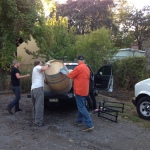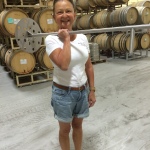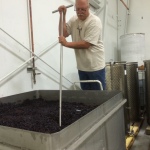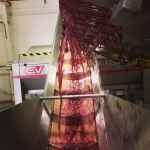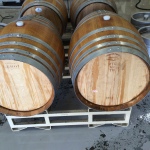Read Part 5 of our Starting J. Cage Cellars – A Family Winery Series
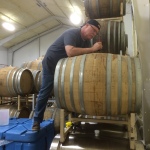 It was the last few days of our harvest and crush for J. Cage Cellars. The Sauvignon Blanc and Viognier that Donna and I had watched over so closely during the last weeks of ripening were fully fermented and safely tucked into their barrels, resting until they are ready to share. Our Pinot Noir from Nunes Vineyard in the Russian River Valley of Sonoma County was nearly finished and ready for press. I, for the first time during this experience, was feeling down and a bit sad. But it took a winemaker friend to describe the emotion accurately.
It was the last few days of our harvest and crush for J. Cage Cellars. The Sauvignon Blanc and Viognier that Donna and I had watched over so closely during the last weeks of ripening were fully fermented and safely tucked into their barrels, resting until they are ready to share. Our Pinot Noir from Nunes Vineyard in the Russian River Valley of Sonoma County was nearly finished and ready for press. I, for the first time during this experience, was feeling down and a bit sad. But it took a winemaker friend to describe the emotion accurately.
The last two weeks had been filled with work in the winery. Both Donna and I found we were missing our time in the vineyard. Early morning, in the solitude of vines, grapes and sunshine, sometimes hidden by a thin layer of coastal fog was a time we learned to cherish. We would walk amongst the rows taking grape samples, checking for quality, sugar levels and overall ripeness. Different areas of the vineyard and different clones of the same grape variety mature at different rates, making choices challenging. We strived to get our first picks as close to perfect as possible, in order to create the hand-crafted wines we had been imagining for our own, J. Cage Cellars.
Winery work had its rewards as well. I had built a good relationship with the team at Healdsburg Custom Crush. Partner, Brian Kobler, was patient with my constant questions and was an excellent teacher. Cellar-hands Jared and Russell were always quick with a helping hand, even in the busiest of times. Younger yet far more experienced winemakers, Micah Wirth of Joseph Jewell Wines and Brooks Friedeman of Friedeman Wines, also made wines at HCC. Both were always ready to help and consult with decisions, even lending me some of their equipment in a pinch. Other winemakers like Kurt Beitler of Bohème Wines, came through with 5 beautiful 1 and 2-year old French barrels for our Pinot Noir. These relationships and others solidified for me the collegiality amongst Sonoma winemakers. Something missing in much of business. I owe them more than they know.
I looked forward to my daily routine of multiple Pinot Noir punch-downs. Red wines are fermented with the skins and seeds to provide color, texture and depth to the finished wines. The Co2 that is a byproduct of fermentation pushes the skins to the top of our 2-ton fermentation bin. The cap, as it is called, must be pushed back into the fermenting juice a few times each day to get all the skins and seeds have to offer. .
In large wineries, punch-downs are done by machines. But for our craft Pinot, it had to be done by hand. The punch-down tool looked like a 25lb stainless steel potato masher. For other client’s wines, Brian, Jared or Russell would stand on the top edges of the bin and punch away. Me, I opted for a ladder. I did not need to fall four feet to the concrete or fall into a bin, only to be stained by Pinot. (On a side note, son Conch fell into a Pinot bin this year giving his harvest team a good laugh). Early in fermentation, the cap is very hard and difficult to punch-down. During the first few days, it took Jared standing atop our 2-ton bin pushing from the T-handle on the top while I pushed from the mid-handle, just to break the cap. I loved the physicality of it all. Something I don’t experience in my real life and miss now that I have returned.
As the Pinot bubbled away in fermentation bliss (Click Here for a Video Zen Moment of Pinot Fermentation), there were other tasks at hand, like preparing the white wines for barreling and daily sampling of the juice. My favorite days were when Conch could take enough time off from his winery to join me. On those days we made important decisions like yeast choices and when to add it. We also reviewed lab reports and considered their implications for our finished wines.
On the day before we were going to barrel the free run Pinot (now raw wine) and press the skins for their remaining juice, I arrived, as I mentioned earlier, a bit in the dumps, realizing that soon I would be returning to my real life in Colorado. My wine-stained dream was ending. At the winery, I ran into a winemaking friend, Eric Anderson of Roadhouse Winery. Eric noticed my disposition and asked if I was OK. I told him how I was feeling and that in a matter of days I had to leave my wine dreams behind, returning to my desk job and the impending winter snows of Denver. Eric said, “Yeah, I know…it’s like the last day of summer camp. Remember how you and your friends would build that last big bonfire and talk about what a great summer it was? But all along you knew your parents were picking you up in the morning…and school was starting in just a few days.”
Eric was exactly right… that was how it felt…like the last day of summer camp…Winemaker Summer Camp.
In my first article detailing my wine-stained adventure, I wondered whether the reality of finally taking my first real steps towards being a winemaker could live up to my wine-stained dream. This morning a friend of twenty years, called to talk about the whole experience. He asked the question… “Was this just a one-time thing and you got it out of your system? My response was a resounding, “Hell No!… I’m more wine-stained then ever!”
BTW… Eric said I could be a junior counselor next year…..
Please read my other posts in the Starting J. Cage Cellars – A Family Winery Series
